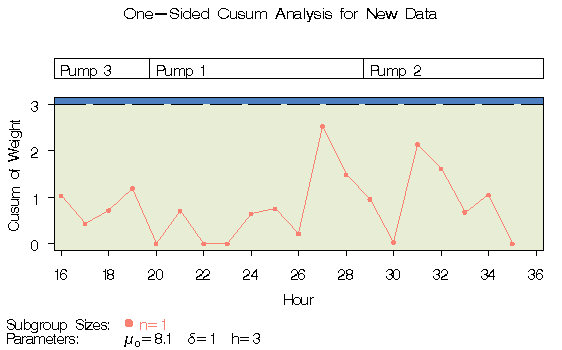Chapter Contents
Previous
Next
|
Chapter Contents |
Previous |
Next |
| XCHART Statement |
| See CUSONES1 in the SAS/QC Sample Library |
This example shows how the cusum parameters saved in the previous example can be applied to new measurements saved in a data set named CANS2:
data cans2;
length pump $ 8;
label hour = 'Hour';
input hour weight pump $ 8. ;
datalines;
16 8.1765 Pump 3
17 8.0949 Pump 3
18 8.1393 Pump 3
19 8.1491 Pump 3
20 8.0473 Pump 1
21 8.1602 Pump 1
22 8.0633 Pump 1
23 8.0921 Pump 1
24 8.1573 Pump 1
25 8.1304 Pump 1
26 8.0979 Pump 1
27 8.2407 Pump 1
28 8.0730 Pump 1
29 8.0986 Pump 2
30 8.0785 Pump 2
31 8.2308 Pump 2
32 8.0986 Pump 2
33 8.0782 Pump 2
34 8.1435 Pump 2
35 8.0666 Pump 2
;
The following statements create a one-sided cusum chart for the measurements in CANS2 using the parameters in CUSPARM:
title "One-Sided Cusum Analysis for New Data";
proc cusum data=cans2 limits=cusparm;
xchart weight*hour ( pump )/ cblocklab = ligr
cinfill = ywh
cframe = bigb
cconnect = salmon
climits = black;
label weight = 'Cusum of Weight';
run;
The LIMITS= option in the PROC CUSUM statement specifies the data set containing preestablished cusum parameters.* The chart, shown in Figure 12.11, indicates that the process is in control. Levels of the variable PUMP (referred to as a block-variable) do not enter into the analysis but are displayed in a block legend across the top of the chart. See "Block Variable Legend Options" in Table 12.7.

|
In general, the parameters for a specified process and subgroup-variable are read from the first observation in the LIMITS= data set for which
If you are maintaining more than one set of cusum parameters for a particular process, you will find it convenient to include a special identifier variable named _INDEX_ in the LIMITS= data set. This must be a character variable of length 16. Then, if you specify READINDEX='value' in the XCHART statement, the parameters for a specified process and subgroup-variable are read from the first observation in the LIMITS= data set for which
In this example, the LIMITS= data set was created in a previous run of the CUSUM procedure. You can also create a LIMITS= data set with the DATA step. See "LIMITS= Data Set" for details concerning the variables that you must provide.
|
Chapter Contents |
Previous |
Next |
Top |
Copyright © 1999 by SAS Institute Inc., Cary, NC, USA. All rights reserved.